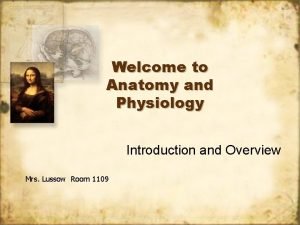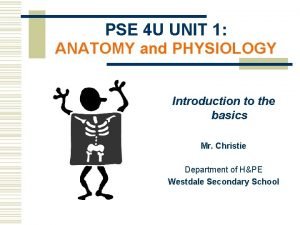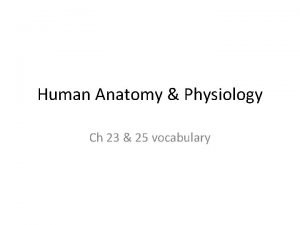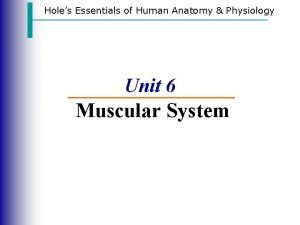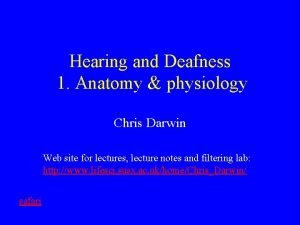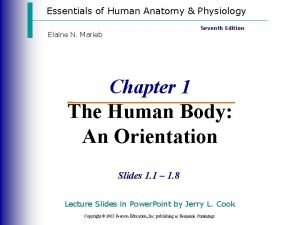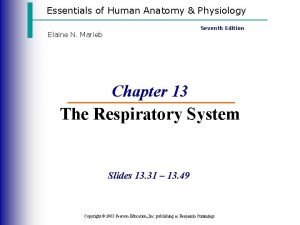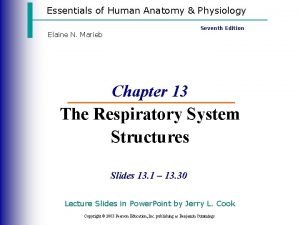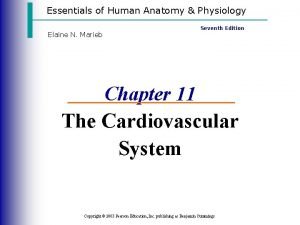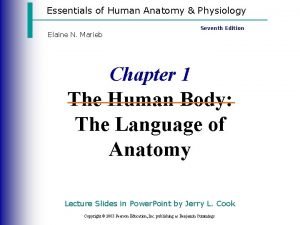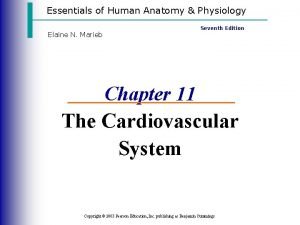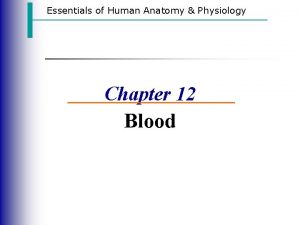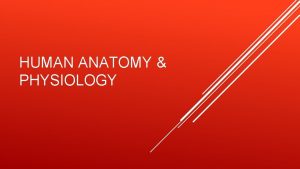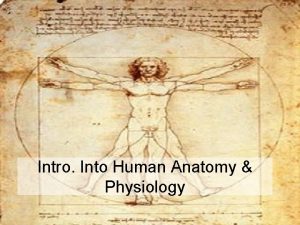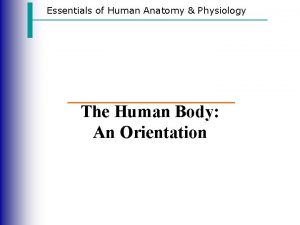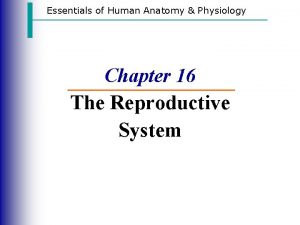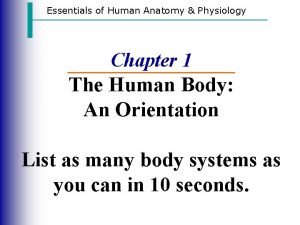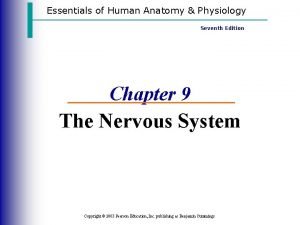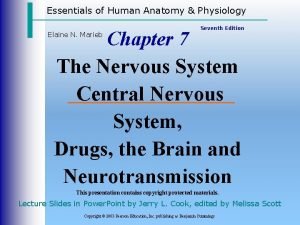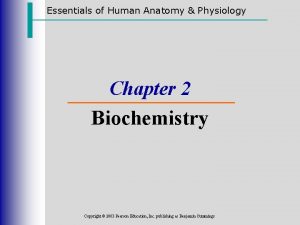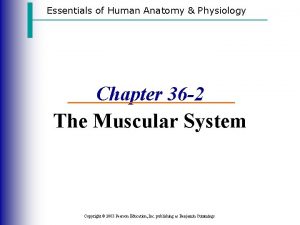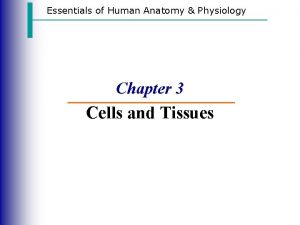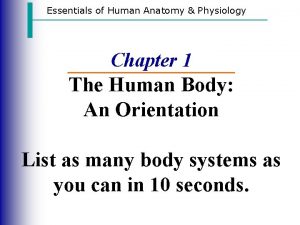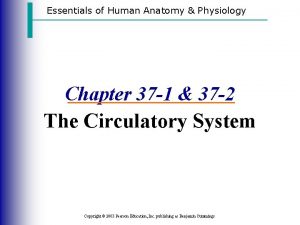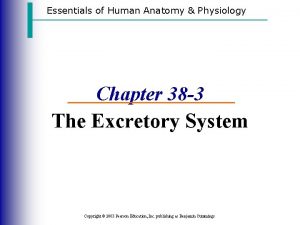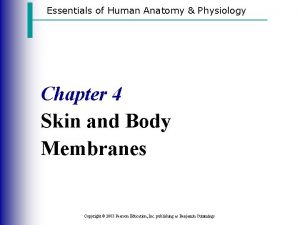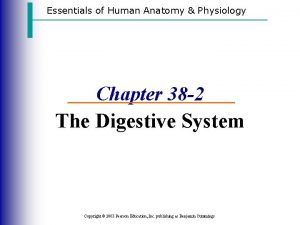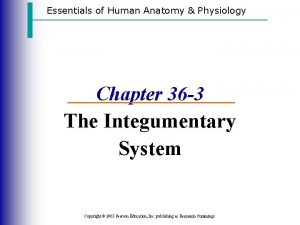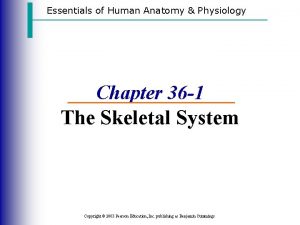Essentials of Human Anatomy Physiology Chapter 38 2


































































- Slides: 66

Essentials of Human Anatomy & Physiology Chapter 38 -2 The Digestive System Copyright © 2003 Pearson Education, Inc. publishing as Benjamin Cummings

The Digestive System Vocabulary Headings Important Info

Overview of GI tract Functions • Mouth: bite, chew, swallow • Pharynx and Esophagus: transport • Stomach: mechanical disruption; absorption of water & alcohol • Small Intestine: chemical & mechanical digestion & absorption • Large Intestine: absorb electrolytes & vitamins (B and K) • Rectum & Anus: defecation

Layers of the GI Tract 1. Mucosal Layer – secretes enzymes & absorbs nutrients 2. Submucosal Layer – containing BV, glands & lymphatic tissue 3. Muscularis Layer – Skeletal: control over swallowing and defecation – Smooth: mixes, crushes & propels food along by peristalsis 4. Serosa Layer – Covers all organs and walls of cavities not open to outside of body – Secretes slippery fluid

Peritoneum • Peritoneum – visceral layer covers organs – parietal layer lines the walls of body cavity • Peritoneal Cavity – potential space containing a bit of serous fluid

Salivary Glands • • Parotid below your ear and over the masseter Submandibular is under lower edge of mandible Sublingual is deep to the tongue in floor of mouth All have ducts that empty into the oral cavity

Composition and Functions of Saliva • Wet food for easier swallowing • Dissolves food for tasting • Protects mouth from infection with its rinsing action: – 1 to 1 ½ qt/day • Bicarbonate ions buffer acidic foods – Bulimia---vomiting hurts the enamel on your teeth • Salivary Amylase (enzyme): – Starts chemical digestion of starch • Lysozyme (enzyme): – helps destroy bacteria

Structure and Function of the Tongue • Muscle of tongue is attached to hyoid, mandible, hard palate and styloid process • Papillae are the bumps: – taste buds are protected by being on the sides of papillae

Tooth Structure & Composition • • Crown Neck Roots Pulp cavity • Enamel – hardest substance in body – calcium phosphate or carbonate • Dentin – calcified connective tissue • Cementum – bone-like – periodontal ligament penetrates it

Dentition • Primary/baby teeth – 20 teeth that start erupting @ 6 months – 1 new pair of teeth per month • Permanent teeth – 32 teeth erupt b/t 6 & 12 years of age – differing structures indicate function • incisors for biting • Canines/cuspids for tearing • premolars & molars for crushing/grinding food

Primary and Secondary Dentition

Digestion in the Mouth • Mechanical Digestion (Mastication/Chewing) • breaks into pieces • mixes with saliva forming: Bolus • Chemical Digestion – Amylase • begins starch digestion at: – p. H of 6. 5 or 7. 0 found in mouth • when bolus & enzyme hit p. H 2. 5 gastric juices hydrolysis ceases – Lingual Lipase • secreted by glands in tongue • begins breakdown of triglycerides into fatty acids and glycerol

• • • Pharynx Funnel-shaped tube extending from internal nares to the esophagus (posteriorly) and larynx (anteriorly) Skeletal muscle lined by mucous membrane Deglutition/swallowing is facilitated by saliva and mucus 1. starts when bolus is pushed into the oropharynx 2. sensory nerves send signals to deglutition center in brainstem 3. soft palate is lifted to close nasopharynx 4. larynx is lifted as epiglottis is bent to cover glottis

Esophagus • Collapsed muscular tube • In front of vertebrae • Posterior to trachea • Posterior to the heart • Pierces the diaphragm at hiatus – hiatal hernia or diaphragmatic hernia

Physiology of the Esophagus - Swallowing • Voluntary Phase: tongue pushes food to back of oral cavity • Involuntary Phase: pharyngeal stage – breathing stops & airways are closed – soft palate & uvula are lifted to close off nasopharynx – vocal cords close – epiglottis is bent over airway as larynx is lifted

Swallowing • Upper sphincter relaxes when larynx is lifted • Peristalsis pushes food down – circular fibers behind bolus – longitudinal fibers in front of bolus shorten the distance of travel • Travel time: – 4 -8 seconds for solids – 1 sec for liquids • Lower sphincter relaxes as food approaches

Gastroesophageal Reflex Disease • If lower sphincter fails to open – distension of esophagus feels like chest pain or heart attack • If lower sphincter fails to close – stomach acids enter esophagus & cause heartburn (GERD) – for a weak sphincter---don't eat a large meal & lay down in front of TV – smoking & alcohol make sphincter relax worsening situation • Control symptoms by avoiding – coffee, chocolate, tomatoes, fatty foods, onions & mint – take Tagamet HB or Pepcid AC 60 minutes before eating – neutralize existing stomach acids with Tums

Anatomy of Stomach • Parts of stomach – – Cardia Fundus Body Pylorus: • starts to narrow as approaches Pyloric Sphincter • Empties as small squirts of chyme leave the stomach through the pyloric valve

Pylorospasm and Pyloric Stenosis • Abnormalities of the pyloric sphincter in infants • Pylorospasm – muscle fibers of sphincter fail to relax trapping food in the stomach – vomiting occurs to relieve pressure • Pyloric Stenosis – narrowing of sphincter indicated by projectile vomiting – must be corrected surgically

Histology of the Stomach

Mucosa & Gastric Glands • Hydrochloric acid converts pepsinogen from chief cell to pepsin • Intrinsic factor – absorption of vitamin B 12 for RBC production • Gastrin hormone (g cell) – “get it out of here” – release more gastric juice – increase gastric motility – relax pyloric sphincter – constrict esophageal sphincter preventing entry

Muscularis • Three layers of smooth muscle: – Outer Longitudinal – Circular – Inner Oblique • Permits greater churning & mixing of food with gastric juice

Physiology of Digestion— Mechanical vs. Chemical • Gentle mixing waves – every 15 to 25 seconds – mixes bolus with 2 quarts/day of gastric juice to turn it into chyme (a thin liquid) • More vigorous waves – travel from body of stomach to pyloric region • Intense waves near pylorus – opens & squirts out 1 -2 teaspoons full w/each wave • Protein digestion begins –HCl denatures protein molecules –HCl transforms Pepsinogen into Pepsin –breaks peptide bonds b/t certain a. a. • Fat digestion continues –gastric lipase splits the triglycerides in milk fat –most effective at p. H 5 to 6 (infant stomach) • HCl kills microbes in food • Mucous cells protect stomach walls from being digested w/13 mm thick layer of mucous

Cephalic Phase = “Stomach Getting Ready” • Cerebral Cortex: – sight, smell, taste & thought – stimulate PNS • Vagus Nerve: – increases stomach muscle and glandular activity

Gastric Phase = “Stomach Working” • Nervous control keeps stomach active – stretch receptors & chemoreceptors provide info – vigorous peristalsis and glandular secretions continue – chyme is released into duodenum • Endocrine influences over stomach activity – distention & presence of caffeine or protein cause G cells secretion of gastrin into bloodstream – gastrin hormone increases stomach glandular secretion – gastrin hormone increases stomach churning and sphincter relaxation

Intestinal Phase = “Stomach Emptying” • Stretch receptors in duodenum slow stomach activity & increase intestinal activity • Distension, fatty acids or sugar signals medulla – SNS slow stomach activity • Hormonal influences – secretin hormone decreases stomach secretions – Cholecystokinin (CCK) decreases stomach emptying – Gastric Inhibitory Peptide (GIP) decreases stomach secretions, motility & emptying

Absorption of Nutrients by the Stomach • • Water especially if it is cold Electrolytes Some drugs (especially aspirin) & alcohol Fat content in the stomach slows the passage of alcohol to the intestine where absorption is more rapid • Gastric mucosal cells contain alcohol dehydrogenase that converts some alcohol to acetaldehyde – more of this enzyme found in males than females • Females have less total body fluid that same size male so end up w/higher blood alcohol levels with same intake of alcohol

• Gastrin Digestive Hormones – stomach, gastric & ileocecal sphincters • Gastric inhibitory peptide--GIP – stomach & pancreas • Secretin – pancreas, liver & stomach • Cholecystokinin--CCK – pancreas, gallbladder, sphincter of Oddi, & stomach

Digestive Enzymes • When chyme enters the duodenum, proteins & carbohydrates are only partly digested, & fat digestion needs to be carried out • Enzymes aid in digestive breakdown & absorption of chyme _______________________________ Bile Salts (Liver & Gallbladder) Pancreatic & Salivary Amylase (Pancreas & Mouth Fat Droplets Starch + H 2 O Maltose Bile is a thick digestive fluid secreted by the liver and stored in gallbladder. Facilitates digestion by emulsifying fats into fatty acids, which can be absorbed by the digestive tract Trypsin & Pepsin (Pancreas) Protein + H 2 O Peptides Lipase (Pancreas) Fat Droplets + H 2 O Glycerol + Fatty Acids Peptidases (Intestinal Juice) Peptides + H 2 O Amino Acids Maltase (Intestinal Juice) Maltose + H 2 O Glucose

Vomiting (Emesis): Reverse Peristalsis 1. A deep breath is taken, the glottis is closed, and the larynx is raised to open the upper esophageal sphincter. Soft Palate is elevated to close of external nares 2. Diaphragm contracts down to create a negative pressure in the thorax, which facilitates opening of the esophagus and esophageal sphincter 3. Simultaneously with the downward movement of the diaphragm, the abdominal muscles contract elevating inner gastric pressure. With the pylorus closed and the esophagus open the exit route is clear

Anatomy of the Pancreas • 5" long by 1" thick • Head close to curve in C-shaped duodenum • Main duct joins common bile duct from liver • Sphincter of Oddi on major duodenal papilla – Bile and pancreatic secretions enter the digestive system through this point • Opens 4" below pyloric sphincter

Composition and Functions of Pancreatic Juice • • • 1. 5 Quarts/day p. H 7. 1 to 8. 2 Contains water, enzymes & sodium bicarbonate • Digestive enzymes – pancreatic amylase, pancreatic lipase, proteases – Ribonuclease • to digest nucleic acids – deoxyribonuclease

Pancreatitis: • inflammation of the pancreas occurring with the mumps Acute Pancreatitis: • associated with heavy alcohol intake or biliary tract obstruction – result is patient secretes trypsin in pancreas & starts to digest themselves

Regulation of Pancreatic Secretions • Secretin – acidity in intestine causes increased sodium bicarbonate release • GIP – fatty acids & sugar causes increased insulin release • CCK – fats and proteins cause increased digestive enzyme release

Anatomy of the Liver and Gallbladder • Liver – – – weighs 3 lbs. below diaphragm right lobe larger gallbladder on right lobe size causes right kidney to be lower than left • Gallbladder – fundus, body & neck – The gallbladder stores about 50 ml of bile

Liver Functions—Carbohydrate Metabolism • Turn proteins glucose • Turn triglycerides glucose • Turn excess glucose glycogen & store in the liver • Turn glycogen back glucose as needed

Liver Functions: Lipid Metabolism • Synthesize cholesterol • Synthesize lipoproteins – HDL (high-density lipoprotein) lipoprotein • helps move cholesterol back to liver for removal from bloodstream (GOOD) – LDL (low-density lipoprotein) lipoprotein • helps cholesterol stick to artery walls (BAD) • Breaks down some fatty acids

Liver Functions: Protein Metabolism • Deamination = removes NH 2 (amine group) from amino acids so can use what is left as energy source • Converts resulting toxic ammonia (NH 3) into urea for excretion by the kidney • Synthesizes plasma proteins utilized in clotting mechanism and immune system • Convert one amino acid into another

Other Liver Functions • Detoxifies blood by removing or altering drugs & hormones (thyroid & estrogen) • Removes the waste product: – Bilirubin • Releases bile salts help digestion by emulsification • Stores fat soluble vitamins: – A, B 12, D, E, K • Stores iron and copper • Phagocytizes worn out blood cells & bacteria • Activates Vitamin D: – the skin can also do this with 1 hr of sunlight a week

Bile Production • 1 quart of bile/day is secreted by the liver – yellow-green in color & p. H 7. 6 to 8. 6 • Components – water & cholesterol – Bile Salts = Na & K salts of bile acids – Bile Pigments (bilirubin) from hemoglobin molecule • Globin = a reuseable protein • Heme = broken down into iron and bilirubin

Pathway of Bile Secretion • Bile capillaries • Hepatic ducts connect to form common hepatic duct • Cystic duct from gallbladder & common hepatic duct join to form common bile duct • Common bile duct & pancreatic duct empty into duodenum

Regulation of Bile Secretion

Blood Supply to the Liver • Hepatic Portal Vein – nutrient rich blood from stomach, spleen & intestines • Hepatic artery branch off the aorta

Anatomy of the Small Intestine • 20 feet long: 1 inch in diameter • Large surface area for majority of absorption • 3 parts – Duodenum: 10 inches – Jejunum: 8 feet – Ileum: 12 feet • ends at Ileocecal Valve

• Plica Circularis – permanent ½ inch tall folds that contain part of submucosal layer – not found in lower ileum – cannot stretch out like stomach • Villi – 1 Millimeter tall – Contains vascular capillaries and lacteals (lymphatic capillaries) • Microvilli – Absorption and digestion – Digestive enzymes found at cell surface on microvilli – Digestion occurs at cell surfaces Small Intestine

Small Intestine: Regions and Structures

Mechanical Digestion in Small Intestine • Weak peristalsis in comparison to the stomach: – chyme remains for 3 to 5 hours • Segmentation: – local mixing of chyme with intestinal juices • sloshing back & forth

Digestion of Carbohydrates • Mouth: salivary amylase • Esophagus & stomach: nothing happens • Duodenum: pancreatic amylase • Brush Border Enzymes (maltase, sucrase & lactose) act on disaccharides – produces monosaccharides-fructose, glucose & galactose – lactose intolerance (no enzyme; bacteria ferment sugar)--gas & diarrhea Digestion of Nucleic Acids • Pancreatic juice contains 2 nucleases –ribonuclease which digests RNA –deoxyribonuclease which digests DNA • Nucleotides produced are further digested by brush border enzymes • Absorbed by active transport

Digestion of Proteins • Stomach – HCl denatures or unfolds proteins – pepsin turns proteins into peptides • Pancreas – digestive enzymes: split peptide bonds b/t different amino acids – brush border enzymes: split off amino acid at amino end of molecule or split dipeptide Digestion of Lipids • Mouth: lingual lipase • Small intestine –emulsification by bile –Pancreatic Lipase: – splits into fatty acids & monoglyceride –No enzymes in brush border

Absorption in Small Intestine

Absorption of Monosaccharides • Absorption into epithelial cell – glucose & galactose: sodium symporter(active transport) – Fructose: facilitated diffusion • Movement out of epithelial cell into bloodstream – by facilitated diffusion Absorption of Amino Acids & Dipeptides • Absorption into epithelial cell –active transport w/Na+ or H+ ions • Movement out of epithelial cell into blood –diffusion

Absorption of Lipids • Small fatty acids enter cells & then blood by simple diffusion • Larger lipids exist only within micelles (bile salts coating) • Lipids enter cells by simple diffusion leaving bile salts behind in gut • Bile salts reabsorbed into blood & reformed into bile in the liver

Absorption of Electrolytes • Sources of electrolytes – GI secretions & ingested foods and liquids • Enter epithelial cells by diffusion & secondary active transport – sodium & potassium move = Na+/K+ pumps (active transport) – chloride, iodide and nitrate = passively follow – iron, magnesium & phosphate ions = active transport • Intestinal Ca+ absorption requires vitamin D & parathyroid hormone

Absorption of Vitamins • Fat-Soluble Vitamins – A, D, E, K – travel in micelles & are absorbed by simple diffusion • Water-Soluble Vitamins – Vitamin B complex, Ca – absorbed by diffusion • B 12 combines with intrinsic factor before it is transported into the cells – receptor mediated endocytosis

Absorption of Water • 9 liters of fluid dumped into GI tract each day • Small intestine reabsorbs 8 liters • Large intestine reabsorbs 90% of that last liter • Absorption is by osmosis through cell walls into vascular capillaries inside villi

• • Anatomy of Large Intestine 5 feet long by 2½ inches in diameter Ascending & descending colon are retroperitoneal Cecum & appendix Rectum = last 8 inches of GI tract anterior to the sacrum & coccyx • Anal canal = last 1 inch of GI tract – internal sphincter----smooth muscle & involuntary – external sphincter----skeletal muscle & voluntary control

Appendicitis • Inflammation of the appendix due to blockage of the lumen by chyme, foreign body, carcinoma, stenosis, or kinking • Symptoms – high fever, elevated WBC count, neutrophil count above 75% – referred pain, anorexia, nausea and vomiting – pain localizes in right lower quadrant • Infection may progress to gangrene and perforation within 24 to 36 hours

Mechanical Digestion in Large Intestine • Smooth muscle: mechanical digestion • Peristaltic Waves – 3 to 12 contractions/minute • Haustral Churning: – relaxed pouches filled from below by muscular contractions (elevator) • Gastroileal Reflex – when stomach is full, gastrin hormone relaxes ileocecal sphincter so small intestine will empty and make room • Gastrocolic Reflex – when stomach fills, a strong peristaltic wave moves contents of transverse colon into rectum

Chemical Digestion in Large Intestine • No enzymes are secreted only mucous • Bacterial Fermentation – undigested carbohydrates into carbon dioxide & methane gas – undigested proteins into simpler substances (indoles)----odor – turn bilirubin into simpler substances that produce color • Bacteria produce vitamin K and B in colon

Absorption & Feces Formation in Large Intestine • Some electrolytes: – Na+ and Cl- • After 3 to 10 hours, 90% of H 2 O has been removed from chyme • Feces are semisolid by time reaches transverse colon • Feces = dead epithelial cells, undigested food such as cellulose, bacteria (live & dead)

Defecation • Gastrocolic reflex moves feces into rectum • Stretch receptors signal sacral spinal cord • Parasympathetic nerves contract muscles of rectum & relax internal anal sphincter • External sphincter is voluntarily controlled

Defecation Problems • Diarrhea – chyme passes too quickly through intestine – H 20 not reabsorbed • Constipation – decreased intestinal motility – too much water is reabsorbed – Remedy = fiber, exercise and water

Dietary Fiber • Insoluble Fiber – Woody parts of plants (wheat bran, veggie skins) – speeds up transit time & reduces colon cancer • Soluble Fiber – gel-like consistency – beans, oats, citrus white parts, apples – lowers blood cholesterol by preventing reabsorption of bile salts so liver has to use cholesterol to make more

Aging and the Digestive System • Changes that occur: – decreased secretory mechanisms & motility – loss of strength & tone of muscular tissue – changes in neurosensory feedback – diminished response to pain & internal stimuli • Symptoms: – sores, loss of taste, peridontal disease, difficulty swallowing, hernia, gastritis, ulcers, malabsorption, jaundice, cirrhosis, pancreatitis, hemorrhoids and constipation – Colon or rectum is common

Categories of Nutrients • Carbohydrates – Most are derived from plants – Exceptions: lactose from milk and small amounts of glycogens from meats • Lipids – Saturated fats from animal products – Unsaturated fats from nuts, seeds, and vegetable oils – Cholesterol from egg yolk, meats, and milk products • Proteins – Complete proteins – contain all essential amino acids • Most are from animal products – Legumes and beans also have proteins, but are incomplete • Vitamins – Most vitamins are used as cofactors and act with enzymes – Found in all major food groups • Minerals – Play many roles in the body – Most mineral-rich foods are vegetables, legumes, milk, & some meats

Metabolism The sum of all chemical reactions necessary to maintain life • Catabolism • Substance is broken down to simpler products • Energy is released • Anabolism • Larger molecules are built from smaller ones • Energy Required
 Chapter 1 introduction to human anatomy and physiology
Chapter 1 introduction to human anatomy and physiology Chapter 1 introduction to anatomy and physiology
Chapter 1 introduction to anatomy and physiology Chapter 2 human reproductive anatomy and physiology
Chapter 2 human reproductive anatomy and physiology Human anatomy and physiology seventh edition marieb
Human anatomy and physiology seventh edition marieb Holes essential of human anatomy and physiology
Holes essential of human anatomy and physiology Paratubular cyst
Paratubular cyst Anatomy and physiology edition 9
Anatomy and physiology edition 9 The central sulcus divides which two lobes? (figure 14-13)
The central sulcus divides which two lobes? (figure 14-13) Anatomy and physiology chapter 8 special senses
Anatomy and physiology chapter 8 special senses Chapter 13 anatomy and physiology of pregnancy
Chapter 13 anatomy and physiology of pregnancy Anatomy and physiology chapter 2
Anatomy and physiology chapter 2 Chapter 7:9 lymphatic system
Chapter 7:9 lymphatic system Anatomy and physiology coloring workbook chapter 14
Anatomy and physiology coloring workbook chapter 14 Chapter 10 blood anatomy and physiology
Chapter 10 blood anatomy and physiology Anatomy and physiology chapter 15
Anatomy and physiology chapter 15 Necessary life functions anatomy and physiology
Necessary life functions anatomy and physiology Holes anatomy and physiology chapter 1
Holes anatomy and physiology chapter 1 Gi tract histology
Gi tract histology Anatomy and physiology chapter 8 skeletal system
Anatomy and physiology chapter 8 skeletal system Chapter 6 general anatomy and physiology
Chapter 6 general anatomy and physiology Anterior posterior ventral dorsal
Anterior posterior ventral dorsal Upper airway anatomy
Upper airway anatomy Tattoo anatomy and physiology
Tattoo anatomy and physiology Science olympiad anatomy and physiology
Science olympiad anatomy and physiology Crown plants examples
Crown plants examples Anatomy and physiology bone
Anatomy and physiology bone Gastric ulcer
Gastric ulcer Segmental anatomy of the liver
Segmental anatomy of the liver Epigastric region
Epigastric region Epigastric region
Epigastric region Straw coloured fluid
Straw coloured fluid Http://anatomy and physiology
Http://anatomy and physiology Anatomy and physiology of appendicitis
Anatomy and physiology of appendicitis Aohs foundations of anatomy and physiology 1
Aohs foundations of anatomy and physiology 1 Aohs foundations of anatomy and physiology 1
Aohs foundations of anatomy and physiology 1 Anatomical planes
Anatomical planes Teks anatomy and physiology
Teks anatomy and physiology Science olympiad forensics cheat sheet
Science olympiad forensics cheat sheet Contraction
Contraction Anatomy and physiology of pancreas
Anatomy and physiology of pancreas Aohs foundations of anatomy and physiology 1
Aohs foundations of anatomy and physiology 1 Aohs foundations of anatomy and physiology 1
Aohs foundations of anatomy and physiology 1 Anatomy and physiology
Anatomy and physiology Cornell notes for anatomy and physiology
Cornell notes for anatomy and physiology Anatomy and physiology unit 7 cardiovascular system
Anatomy and physiology unit 7 cardiovascular system Anatomy and physiology
Anatomy and physiology Aohs foundations of anatomy and physiology 1
Aohs foundations of anatomy and physiology 1 Aohs foundations of anatomy and physiology 1
Aohs foundations of anatomy and physiology 1 Animal physiology exam 1
Animal physiology exam 1 Welcome to anatomy and physiology
Welcome to anatomy and physiology Physiology of the foot and ankle
Physiology of the foot and ankle Anatomy and physiology of psoriasis
Anatomy and physiology of psoriasis Pse4u
Pse4u Pancreas anatomy histology
Pancreas anatomy histology Anatomy and physiology vocabulary
Anatomy and physiology vocabulary Anatomy and physiology
Anatomy and physiology Muschiul subclavicular
Muschiul subclavicular Anatomy and physiology
Anatomy and physiology Body landmarks diagram
Body landmarks diagram Anatomy and physiology
Anatomy and physiology Anatomy and physiology
Anatomy and physiology Thyroid anatomy
Thyroid anatomy Dorsifelxion
Dorsifelxion Anatomy and physiology
Anatomy and physiology Anatomy and physiology
Anatomy and physiology Anatomy and physiology
Anatomy and physiology Figure 10-1 blood
Figure 10-1 blood

















































